Marketing or labelling an experience as “once in a lifetime” or “unforgettable” has become all too commonplace these days but I, for one, can put my hand on my heart and say that my experience of whitewater rafting in the Padas River in Sabah will be etched in my memory for a long time to come.
In short, it was an experience that, in both a literal and metaphorical sense, took my breath away.
Less than 24 hours after climbing and descending Mount Kinabalu, my buddies and I decided to give our arms their fair share of pain that was, hitherto, unevenly distributed to our lower limbs.
The journey to Padas River began in the wee hours of the morning. We left Kota Kinabalu City at 5.30am and drove for two hours to Beaufort Town. It was a good thing that we managed to catch up on our sleep during the drive as the train ride from Beaufort Town to the Padas River – an hour-long journey where you are required to switch trains once at Halogilat – was very scenic and it would have been a pity if we had slept through that. As the train travelled along the Padas River, you could visibly notice the rapids increasing in aggressiveness as we closed in on our destination. We reached Rayoh Station, which is a 20-minute ride to Pangi Station where our journey would begin. At Pangi Station, according to Google Maps, we were equidistant from KK City and Brunei itself.
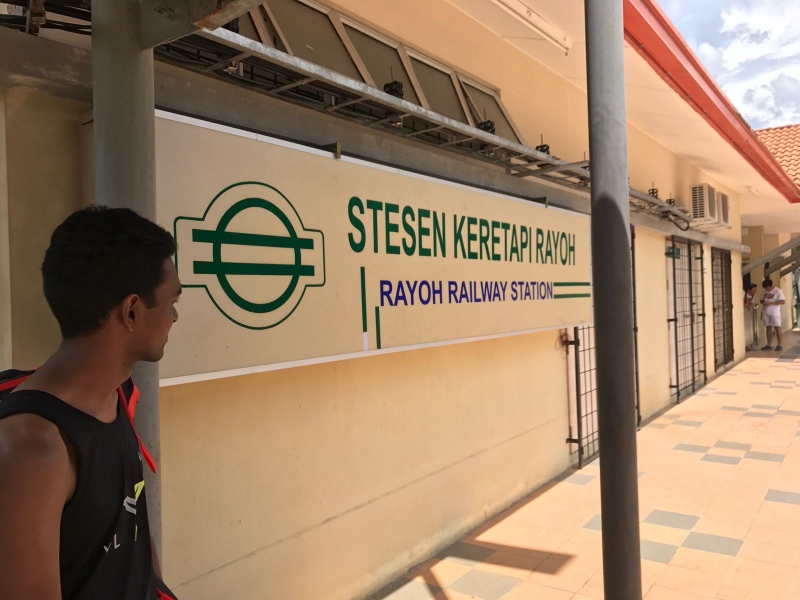
At the river bank, we were given some time to change into our wet clothes and sign an indemnity form. No footwear is allowed on the raft so it’ll be best for you to wear flip-flops. On the morning of 11 August, the sun was out in full force so we were reminded to apply sunblock generously on areas of our skin that were exposed.
After donning our life vests and helmets, we were taken through a safety briefing that acknowledges the real risks that came with the activity that we were about to embark on. Ari, my namesake and the chief instructor, reassured us that as long as we followed his instructions and looked out for one another on the raft, we wouldn’t run into any real trouble. So do be sure to pay close attention and clarify if you have any questions about the briefing.

A photo after Ari’s briefing
The first stretch of the river is pretty calm and relatively safe for capsizing and even, with the aid of a life vest, safe for swimming. This is where you’ll be able to try out some of the things spoken about at the briefing, like how to position yourself if you find yourself in the rapids.
A raft can hold up to eight people but in the raft we were in, there were seven people. Ari and Kelvin were the guides. The guides sat at the rear of the raft and helped to steer the raft through the rapids. The rest of us – 3 Singaporeans and 2 Malaysians (Team Malaya?) – were tasked to simply propel the raft either forward or backwards. During the briefing, Ari recounted many incidents where raft mates did not look out for one another simply because they were from different nationalities. We clicked pretty well with our two Malaysian raft mates, YiYi and AC, so we didn’t have any issues in that department.
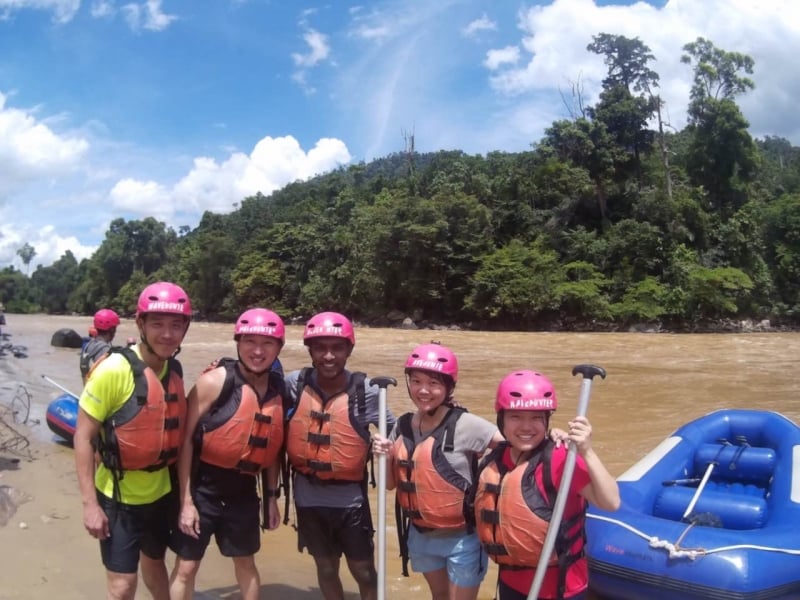
Team Malaya! (Theng Wei, Herman, Ariffin, AC and Yiyi)
Herman and I sat in the front and the two Malaysian girls sat behind us as they were non-swimmers and the back is relatively safer than the front.
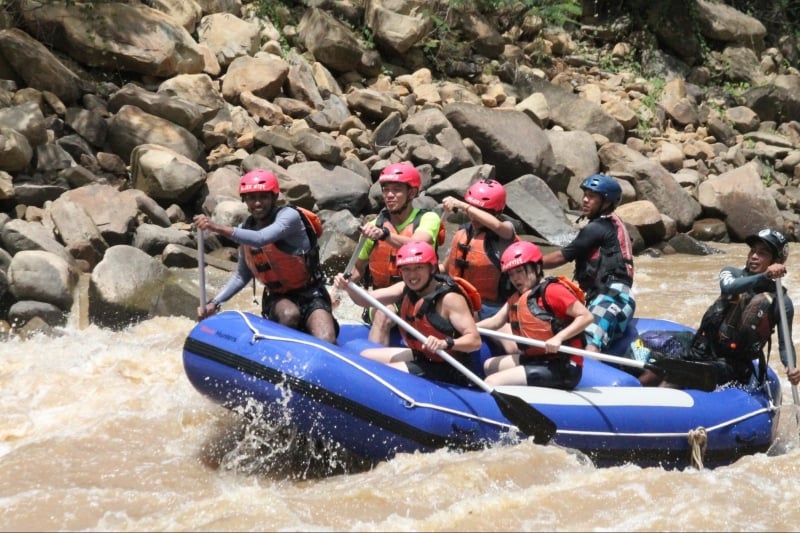
During the first 10 minutes, we took turns to get off (and push each other) off the raft so that we could familiarise ourselves with capsizing and helping our raft mates onto the boat; but as some of us learnt the hard way further along the rapids, no amount of drills could prepare you for the real thing.


Our route stretches 14km and consisted of nine rapids that ranged between Class 3 and Class 4. The rapids have pretty deceptive names, from Lambada to Scooby Doo. The infamous Class 4 Rapid, the ‘Washing Machine’, is probably the only name that does justice to its rapids.
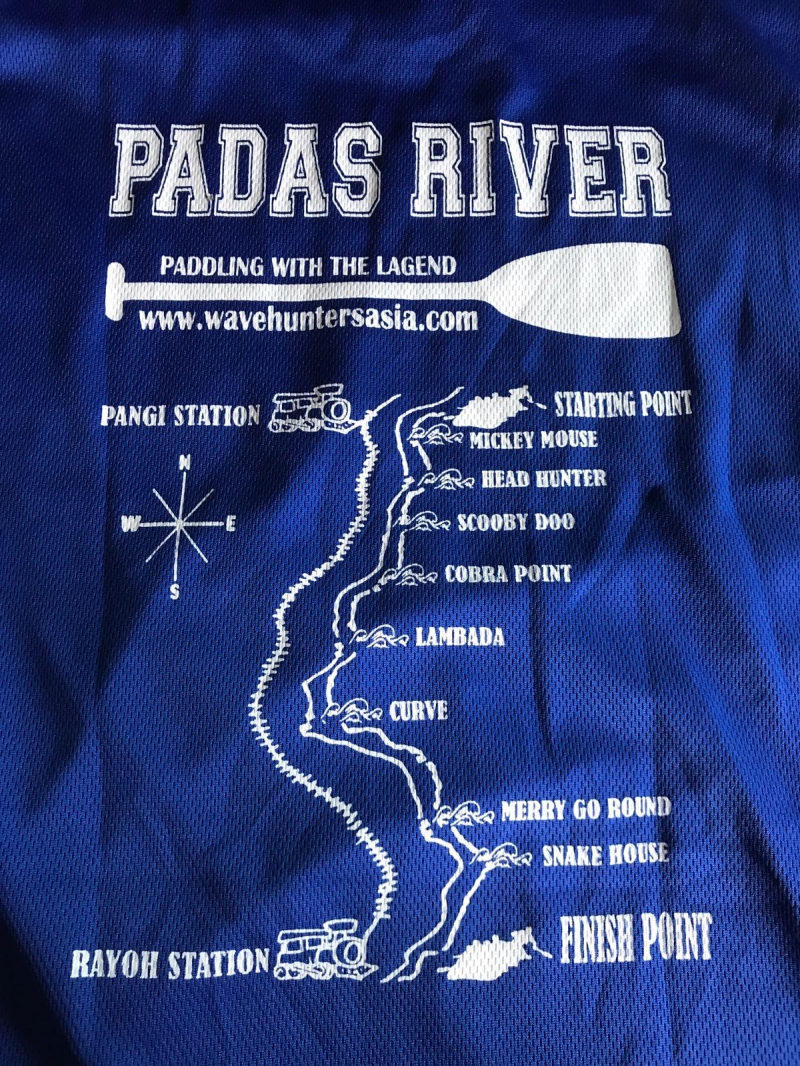
Along the route, there are also photographers employed by the service provider to take photos of our adventure. The amazing thing about these photographers is that they tackle the same rapids that overturn rafts using only a kayak so that they can capture us in action.
We cleared the first three rapids – Headhunter, Scooby Doo and Cobra Point – with relative ease, only to be reminded by Ari that those were but baby rapids. Ari then reminded us that after the upcoming rapid, the Lambada, we’ll have to pose for a photo. He asked us all to put our best smile on.
Lambada was pretty rocky and we had a few close calls. We spotted our photographer in his trusty kayak and just as we were about to clear the rapid, in the words of Theng Wei who was seated behind me, I did a slow-motion backflip from the raft into the river.
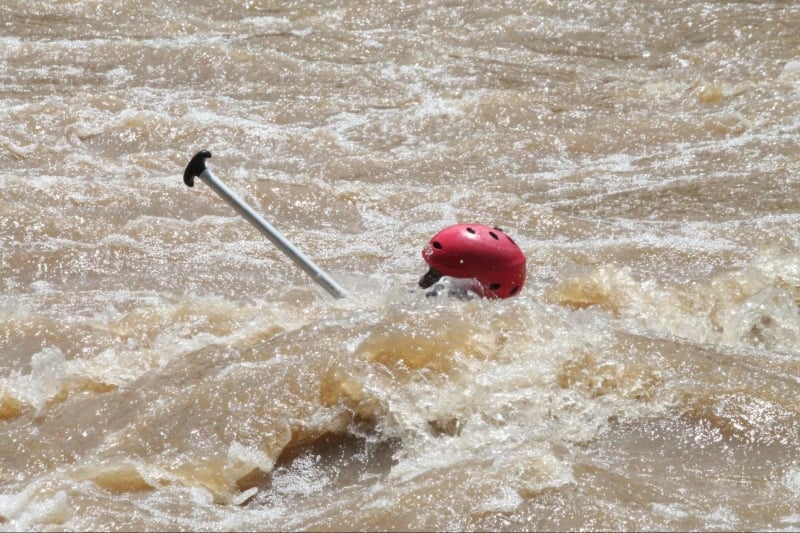
I failed to anchor my legs properly in the raft and didn’t keep a low centre of gravity and when a strong wave hit, I fell into the rapids. We were taught to adopt a body-rafting position, where you hold your life vest and float horizontally on the water along the rapids. (Struggling would be futile and standing vertically may lead to your legs colliding with boulders in the river.) However, adrenaline and panic set in.
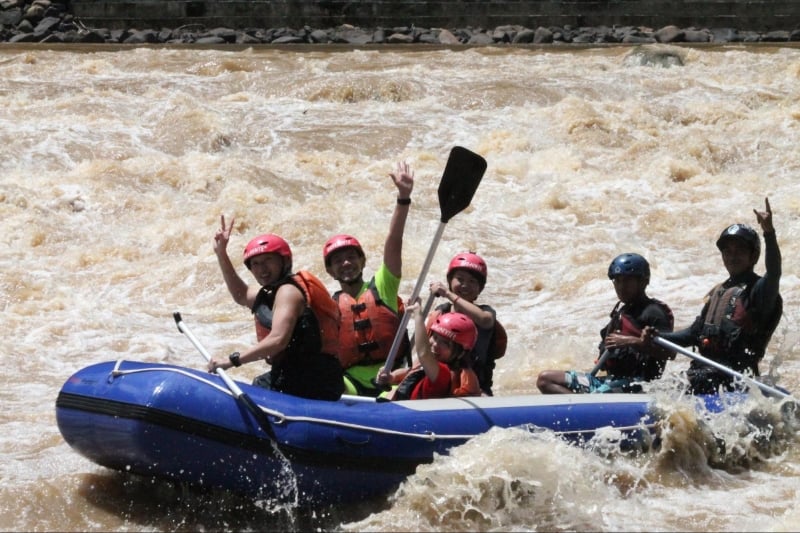
My dear raft buddies were concerned, but they made sure to pose for their photo first before catching up with me and dragging me onto the raft. After some time in the water, one will naturally adopt the body rafting position but it still doesn’t make it any less scary.
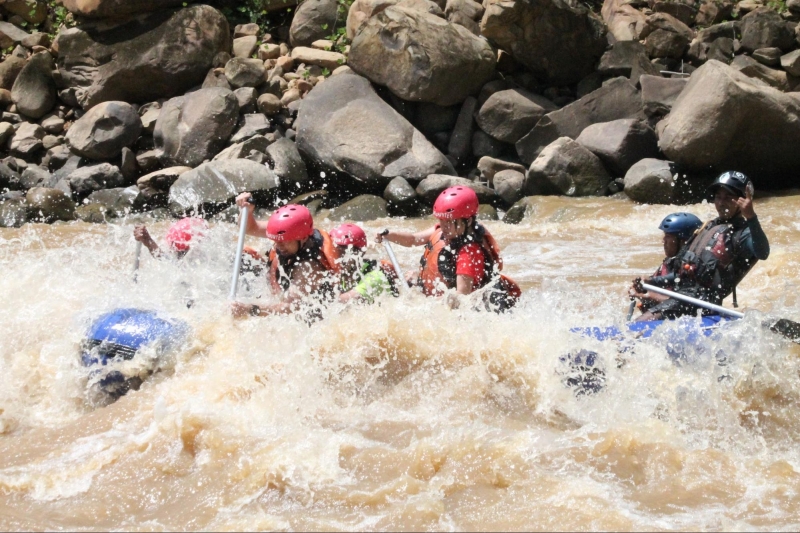
Just after Lambada, there was another relatively calm stretch where, once again, you could get into the water and float/swim. This time, the boys on the raft had a mini ‘King-of-the-Boat’ where we all tried pushing each other off the raft in the name of good fun. Our Malaysian compatriots, who were non-swimmers, also joined us in the river. As we approached the bend, Ari signalled for us to come back into the raft. What lay ahead of us was the infamous ‘Washing Machine’ – a class 4 Rapid.
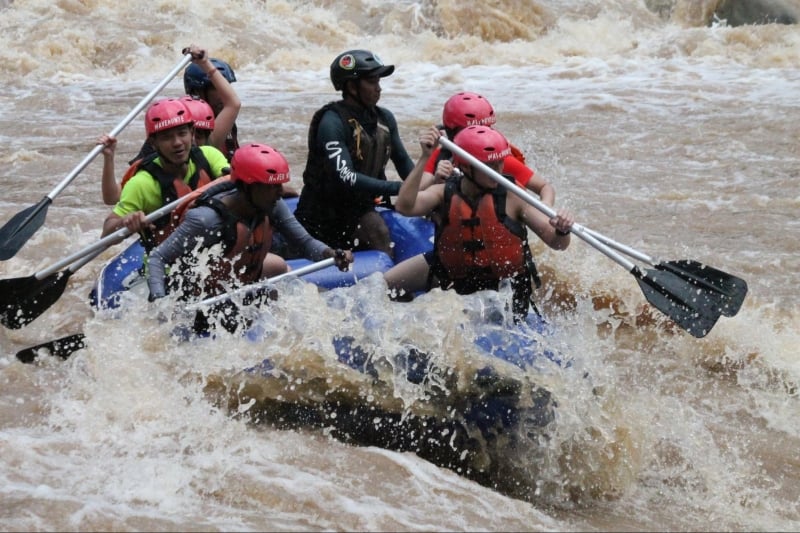
The boat ahead of us seemed to navigate through the washing machine without much trouble, so we thought that we would do likewise. There were a few big waves and whirlpools but aside from a tumble or two, we were safe. Just before we cleared the Washing Machine – a 400m long rapid –, we were hit by a huge wave from the left. What happened next is best explained by the following gif:

Looking at these pictures, the sequence of events looked epic, perhaps even funny. But in the heat of the moment, it was scary as hell. I fell into the boat and then somehow managed to clothesline two fellow rafters – including Yiyi (a non-swimmer) – into the rapids. You would think that I would be more comfortable now in the rapids, after falling into it earlier, but nothing could be further from the truth. We did adopt the body-rafting position but every time we tried to breathe, we were submerged by the onslaught of waves which seemed to be never ending. This picture of three helmets in a sea of brown shows the predicament we were in.
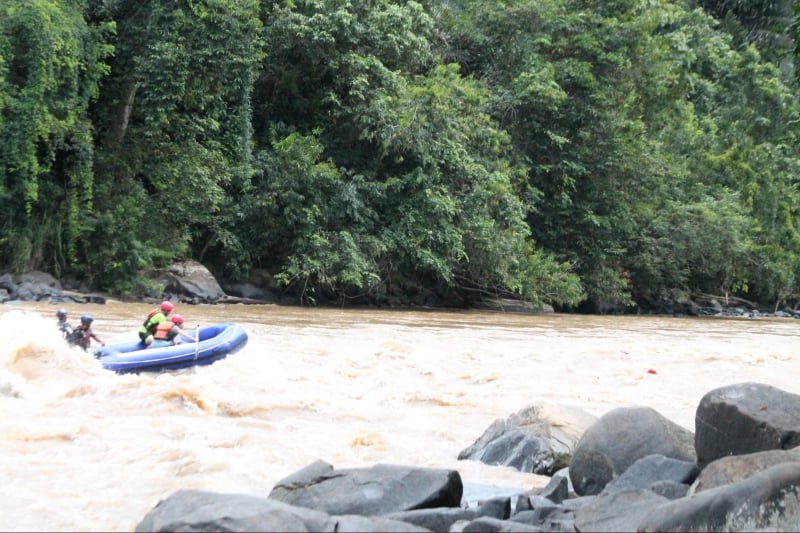
Theng Wei and AC taking the lead as three helmets float in the distance.
On the boat, Theng Wei and AC were in a state of shock as they found the boat half-empty in a matter of seconds. They were stunned but they were instructed by Ari to take up positions at the front of the boat to continue navigating through the rapids. In the rapids, I somehow managed to make my way to Herman and could even ask him if he was ok. In his own words, “I thought the last thing I was going to see was Ariffin’s head in slow motion”.
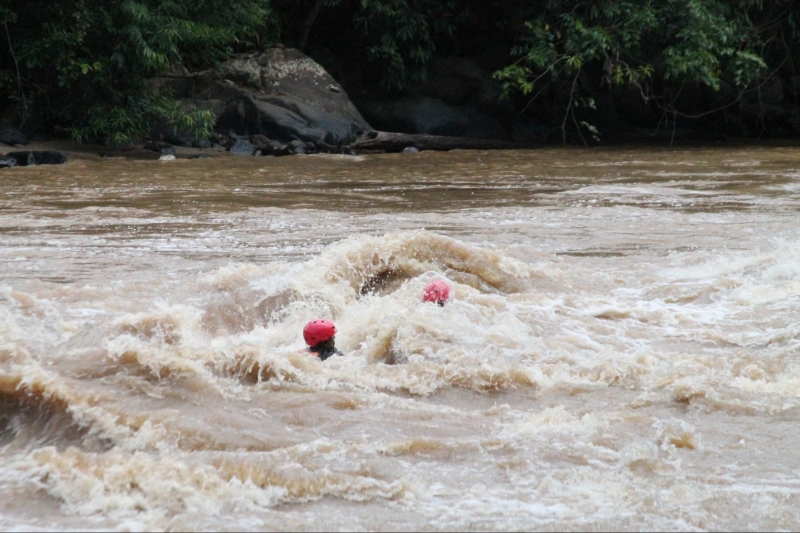
The raft eventually caught up with us and we were pulled on board. Yiyi shared that she felt almost calm in the rapids as she was a non-swimmer and deduced that trying to swim or resist was futile. We didn’t have much time to rest after getting back on as we still had another Class 4 Rapid ahead of us: the Merry-Go-Round.
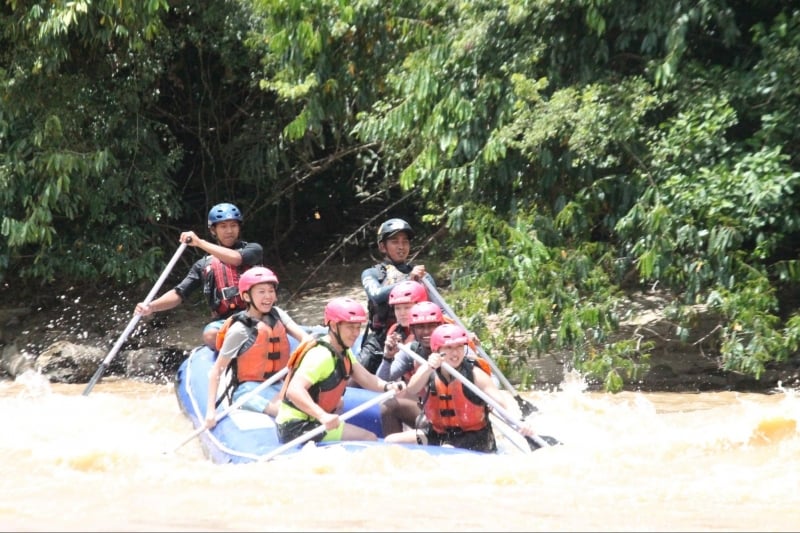
This time, with half the boat determined not to taste the Padas River again, we rowed in unison with renewed energy despite complaining that our arms were aching badly just five minutes earlier. There were a few tricky waves in the Merry-Go-Round and there was once where we all did a ‘Helmet-5’ as we almost fell into the boat (as opposed to falling into the rapids) and knocked our helmets against each other. Ari remarked that our Helmet 5 was a sign of experience as we naturally fell inwards instead of outwards when we lost our balance.
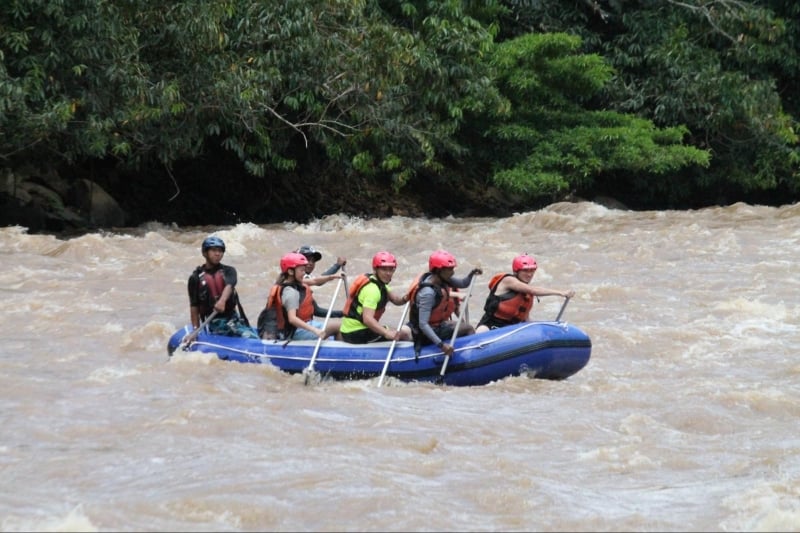
After 14km and more than an hour, we neared the end of the river. We did one last ‘Paddle-5’ and were all smiles. There is quite nothing that bonds strangers as much as near-death experience does, I guess.

Ari later revealed that as the raftmaster, he could have easily avoided the huge waves and given us an experience similar to the boat ahead of us that didn’t capsize, but where was the fun in that. Even though the experience of falling into the rapids was scary Ari assured us that it was nothing close to life-threatening and the only thing we would take away wouldn’t be scars and bruises but great stories. Ari reminded us that in the event that we want to bring families or people who are more risk averse but still want to experience the rapids, the raft masters will be able to, more often than not, navigate through the rapids and avoid any capsize and/or men overboard.
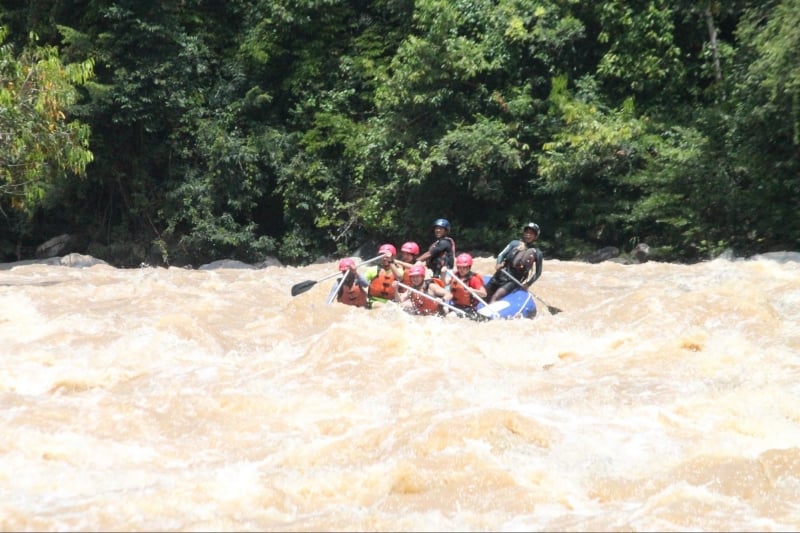
Once back on shore, we enjoyed a nice buffet lunch provided and some well-deserved Tiger Beer. We still had more than an hour before our train back to Beaufort arrived and that gave us ample time to dry up and also check out the photos of our adventure together.
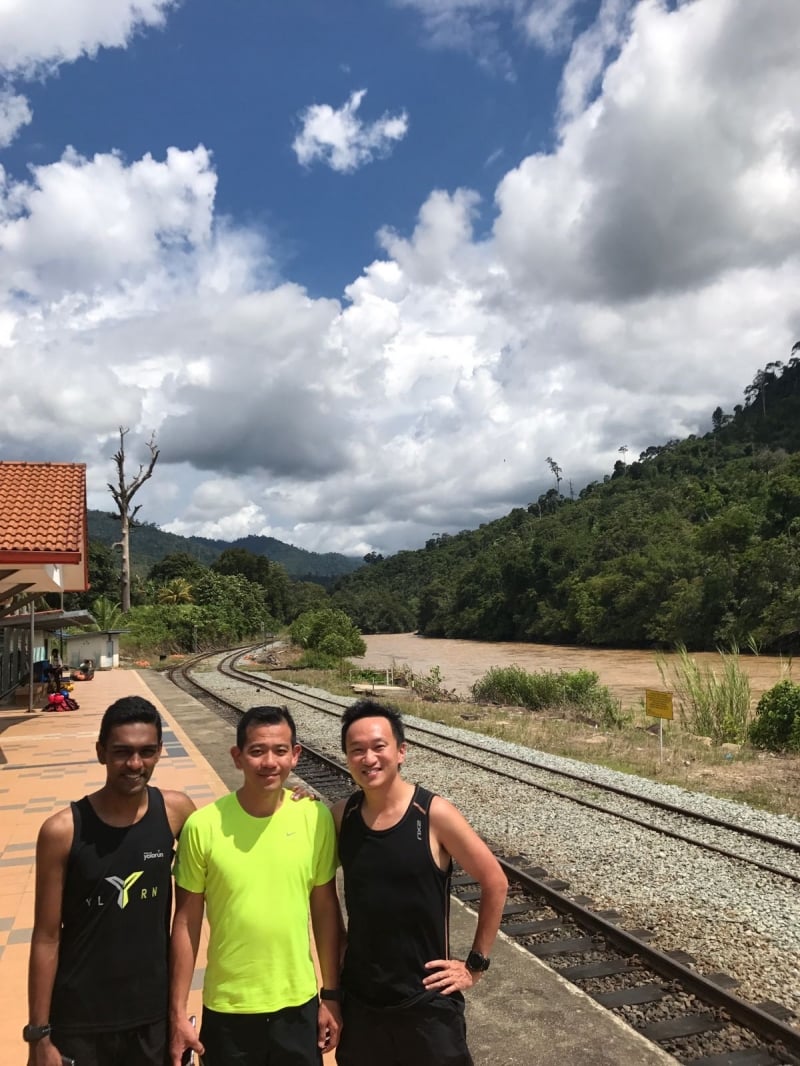
At the Rayoh Station waiting for our train back to Beaufort
Whitewater rafting in the Padas River is a must-try if you are in Kota Kinabalu. Despite the dangerous rapids, more than enough safety precautions are in place to ensure that the only things you take away from the experience are stories, photos and maybe, a new outlook on life.
PS: Herman did share with me that he had some trouble watching videos of Synchronised Swimmers after his experience in the rapids. 😉





